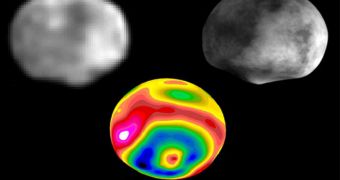The second-largest asteroid in our solar system, Vesta, apparently just gave birth to a new object recently, a mini-asteroid that has been dubbed 1999 AT10. This space rock, which boasts a violent history, could be used to derive more data on the earliest days of the solar system.
One of the most interesting things about this particular rock is that it was not made from the crust of its parent asteroid, as is usually the case with such structures. Chemical analysis have revealed that it was formed from the inner rocky layers of Vesta.
This is the first time such an object was ever imaged, researchers say. Vesta will become the target of NASA observations beginning this summer, when the Dawn spacecraft enters its orbit.
The asteroid will be analyzed between summer 2011 and 2012, before the orbiter exits orbit, and continues its journey to the dwarf planet Ceres. It is scheduled to arrive there in 2015.
Vesta is so important for science because it may be the only protoplanet left behind from the time when all other planets developed, at the beginning of the solar system. The body orbits the Sun in the inner asteroid belt, between the orbits of Mars and Jupiter.
It has a diameter of about 326 miles (525 kilometers), and it is made up of an iron-nickel core covered in a rocky mantle, which is then covered by a crust formed by cooled lava. This is the same type of inner structure that can be found on Earth, Mars, Venus and Mercury.
The new object, 1999 AT10, was discovered with the NASA Infrared Telescope Facility on Mauna Kea, Hawaii, by astronomers from the University of North Dakota and the Max Planck Institute for Solar System Research, in Germany.
Studying the small space objects could enable planetary scientists to obtain more details on the internal structure of Vesta, as well as more refined measurements on the thickness of its crust.
These elements could then be used to infer the processes the protoplanet was subjected to during the formation of the solar system. Researchers could then theorize on what went wrong that Vesta could not develop further into a planet.
One of the possible explanations is that involving an asteroid impact. Observations of the large asteroid have revealed the existence of a large crater in its southern hemisphere. Some believe that many asteroids – now called Vestoids – appeared as a result of that impact.
Details of the new study on 1999 AT10 were recently published in the December 5 issue of the esteemed scientific journal Icarus, Space reports.

 14 DAY TRIAL //
14 DAY TRIAL //